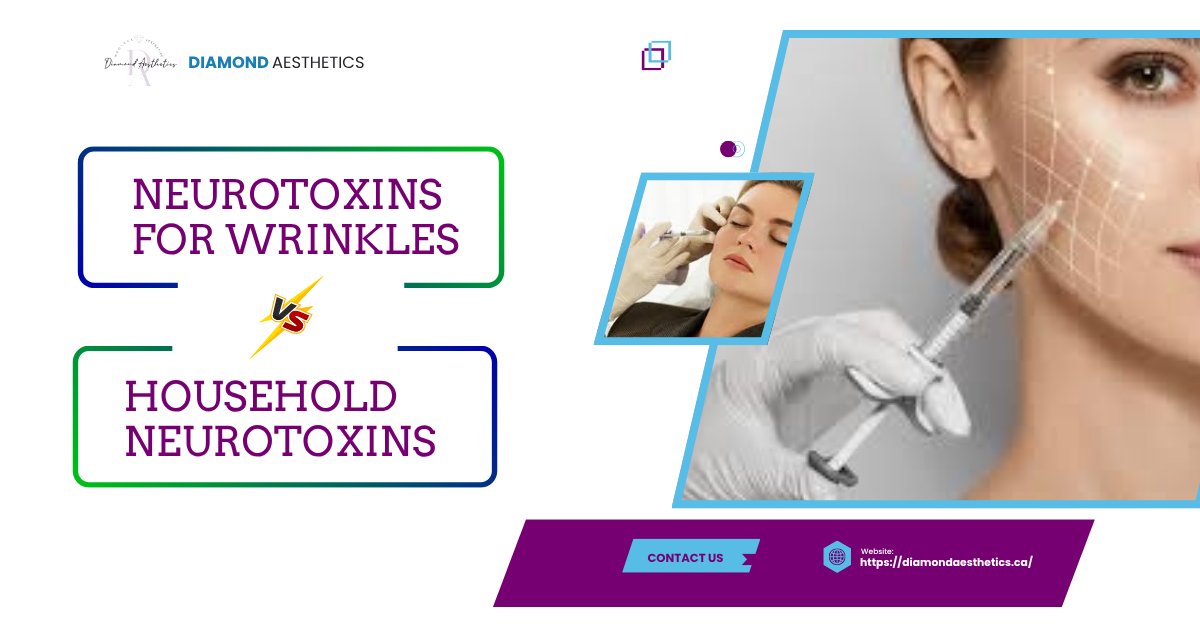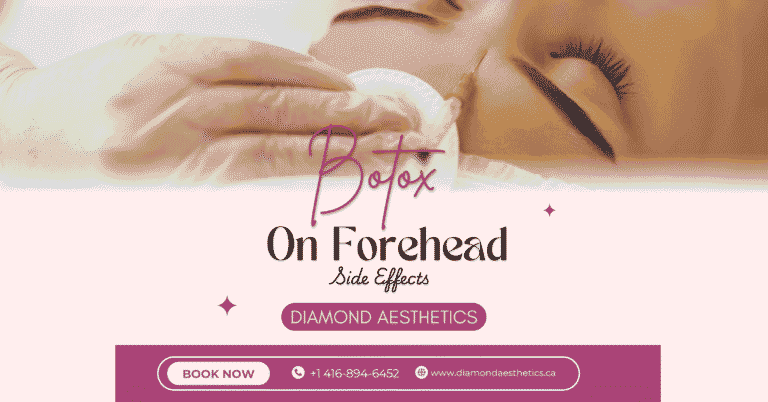When you hear the word “neurotoxin,” your first thought might be of something toxic or harmful. And you’re not wrong—many everyday household items like cleaners, plastics, and pesticides contain neurotoxins that can affect the brain and nervous system over time. However, not all neurotoxins are harmful in the same way. In the world of aesthetic medicine, carefully controlled neurotoxins like Botox and Dysport are used for a very different reason: to smooth wrinkles, relax facial muscles, and give your skin a more youthful, refreshed appearance—safely and effectively.
In this blog, we’ll explore the difference between household neurotoxins and cosmetic neurotoxins, how each impacts the body, and why one should be avoided. At the same time, the other can enhance your confidence.
Neurotoxins for Wrinkles: How They Work and Why They Matter

The term “neurotoxins for wrinkles” may sound intimidating at first, but in modern aesthetic medicine, it represents one of the safest and most effective ways to achieve smoother, younger-looking skin. Neurotoxins used for cosmetic purposes work by temporarily blocking nerve signals that cause facial muscles to contract. This reduction in muscle activity softens existing wrinkles and prevents new lines from forming.
The science behind neurotoxins for wrinkles:
Understanding how these neurotoxins work can help you make an informed decision about facial aesthetics.
- Wrinkles are often caused by repetitive muscle movements such as smiling, frowning, and squinting
- Neurotoxins like Botox or Dysport relax specific facial muscles to reduce dynamic wrinkles
- Over time, the skin appears smoother and more refreshed without altering your natural expression
These treatments are especially effective for targeting forehead lines, frown lines between the eyebrows, and crow’s feet around the eyes. When administered by a trained medical professional, the results are subtle, natural-looking, and tailored to your facial structure.
Neurotoxins for wrinkles are not about “freezing” the face—they’re about restoring balance, softening tension, and enhancing the natural contours of the skin. With repeated sessions, many clients notice that they need fewer units over time as treated muscles gradually learn to relax.
What Are Household Neurotoxins? What You Need to Know
Household neurotoxins are harmful chemicals found in many products we use every day. These include certain cleaning supplies, air fresheners, plastics, pesticides, paint, and synthetic fragrances. Though legal, these chemicals can accumulate in indoor environments and slowly affect the central nervous system over time.
Common Household Neurotoxins and Their Effects
These neurotoxins are more common than most people think, and avoiding them can greatly improve your quality of life.
- Lead – Found in old paints, pipes, and some imported toys. It can impair brain development and cognitive function.
- Formaldehyde – Present in furniture, glues, and fabrics. Known to irritate the respiratory system and trigger headaches.
- Phthalates – Common in plastic packaging, vinyl flooring, and scented items. They disrupt hormone balance and may contribute to neurological damage.
- Pesticides – Used to kill pests, but often linger in the air and on surfaces. Chronic exposure is linked to Parkinson’s disease and memory loss.
- Mercury – Found in fluorescent bulbs and old thermometers. It damages neurons and can affect motor coordination.
Taking steps to reduce your contact with these toxins is a proactive approach to protecting your health.
What Do Household Neurotoxins Do to the Body?

Prolonged exposure to household neurotoxins can result in both short-term and long-term health consequences.
- Memory issues and cognitive decline
- Trouble focusing and learning difficulties
- Depression or anxiety
- Hormonal disruptions
- Developmental delays in children
Reducing exposure may not reverse damage already done, but it can help prevent further harm.
How to Identify and Reduce Exposure to Household Neurotoxins
Improving your home environment can make a major difference in long-term health. Consider the following practices:
Practical Tips to Minimize Toxin Exposure
- Read product labels carefully and choose those labeled “non-toxic” or “phthalate-free.”
- Switch to natural alternatives like vinegar, baking soda, and lemon for cleaning.
- Increase indoor ventilation by opening windows and using air purifiers.
- Use glass or stainless steel containers instead of plastic.
- Avoid synthetic air fresheners, candles with artificial scents, and vinyl products.
- Regularly dust and vacuum to reduce the accumulation of toxins on surfaces.
Even small changes in your product choices can lead to noticeable improvements in health and air quality.
What Are Neurotoxins in Aesthetic Medicine?
Unlike the toxic substances mentioned above, cosmetic neurotoxins are purified, medical-grade compounds used under controlled settings. Products like Botox, Dysport, Xeomin, and Nuceiva are made from botulinum toxin type A and are used to temporarily relax overactive facial muscles.
These treatments target specific areas to reduce the appearance of dynamic wrinkles and fine lines caused by repeated expressions.
How Neurotoxins Help Reduce Wrinkles
Understanding how wrinkle treatments work can help you set realistic expectations and goals.
Forehead lines (horizontal creases)
These lines form from frequent raising of the eyebrows and give the face a tired or stressed look. Neurotoxins help smooth them out for a more relaxed appearance.
Frown lines (vertical lines between eyebrows)
Often called “11 lines,” these appear from squinting or frowning. Treatment softens the area, creating a calmer, more approachable look.
Crow’s feet (around the outer eye corners)
Caused by smiling or squinting, these fine lines can make eyes look aged. Neurotoxins gently reduce them, making the eye area appear brighter and smoother.
Bunny lines (on the nose bridge)
These subtle wrinkles form when scrunching the nose. Treating them helps maintain a smoother nasal bridge without affecting natural expression.
Chin dimpling and fine lines around the lips
Muscle tension around the chin and mouth can lead to uneven texture and lines. Targeted treatment smooths these areas for a more refined and youthful lower face.
By relaxing targeted facial muscles, neurotoxins reduce the depth and severity of existing wrinkles.
Treatment benefits:
Each benefit contributes to a more refreshed, natural appearance without surgery or downtime.
- Reduced appearance of deep wrinkles
- Softer, more youthful facial expression
- Quick treatment with minimal downtime
- Prevention of future lines from forming
With regular maintenance, these effects can become longer-lasting and more noticeable.
Safety and Efficacy of Neurotoxins for Wrinkles
Cosmetic neurotoxins have been rigorously tested and used for decades worldwide. When administered by certified professionals, they are extremely safe.
Short-term side effects may include:
Understanding the possible side effects helps you prepare and manage expectations.
- Mild redness or swelling at the injection site
- Temporary bruising
- Occasional headache
Proper application and aftercare can reduce the risk of any discomfort.
Who Is a Good Candidate for Wrinkle-Reducing Neurotoxins?
These treatments are suitable for a wide range of individuals, including:
Whether you’re targeting current lines or preventing new ones, neurotoxins can be a great solution.
- Adults with visible lines from facial expressions
- Younger clients using them preventively to delay aging
- People looking for a nonsurgical alternative to facelift procedures
A personalized consultation can determine if this treatment is right for your needs.
Comparing Household and Cosmetic Neurotoxins
| Category | Household Neurotoxins | Cosmetic Neurotoxins |
| Purpose | Accidental exposure | Aesthetic treatment |
| Found in | Plastics, pesticides, cleaners | Botox, Dysport, Xeomin, Nuceiva |
| Risk | Chronic harm to the nervous system | Low risk when applied professionally |
| Result | Cognitive and physical harm | Smoother, younger-looking skin |
| Regulation | Often underregulated | Strictly regulated by health authorities |
This comparison highlights the major differences between the two.
Final Thoughts: Understanding the Role of Neurotoxins in Beauty and Health
Not all neurotoxins are created equal. While household neurotoxins can quietly impact your health over time, medically approved cosmetic neurotoxins are carefully formulated to do the opposite; they enhance your appearance safely and effectively. When used by trained professionals, treatments like Botox or Dysport can soften fine lines, smooth wrinkles, and help you look naturally refreshed without compromising your health.
At Diamond Aesthetics, we believe looking good should never come at the cost of your well-being. That’s why our wrinkle-reducing treatments are designed with both safety and results in mind.
If you’re considering this treatment, you can learn more by visiting our Neurotoxins for Wrinkles service or book a consultation with our expert team to find out if it’s the right choice for you.
Common Questions About Neurotoxins for Wrinkles and Household Neurotoxins
What exactly are neurotoxins?
Neurotoxins are substances that affect nerve cells by blocking nerve signals. In household products, they can be harmful chemicals, while in aesthetics, purified neurotoxins are used to relax muscles and reduce wrinkles safely.
Are neurotoxins for wrinkles safe?
Yes, when administered by trained and licensed professionals, cosmetic neurotoxin treatments like Botox are very safe with minimal side effects.
How long do wrinkle treatments with neurotoxins last?
Results typically last between three to four months. Maintenance treatments can prolong the effect.
Do neurotoxins freeze facial expressions?
No. Modern neurotoxin treatments aim to soften muscle activity, not completely freeze facial expressions, maintaining a natural look.
Can exposure to household neurotoxins cause wrinkles?
Indirectly yes. Household neurotoxins can contribute to oxidative stress and inflammation, which may accelerate skin aging and wrinkle formation.
How can I reduce exposure to harmful household neurotoxins?
Use non-toxic cleaning products, increase ventilation, avoid synthetic fragrances, and choose safer materials like glass or stainless steel over plastics.
Who should avoid neurotoxins for wrinkle treatments?
Pregnant or breastfeeding women and individuals with certain neuromuscular disorders should consult a doctor before treatment.




